Last update:
Astronomy news

Hubble goes hunting for small main belt asteroids
Like boulders, rocks, and pebbles scattered across a landscape, asteroids come in a wide range of sizes. Cataloging asteroids in space is tricky because they are faint and they don't stop to be photographed as they zip along ...
Astronomy
15 hours ago
0
150
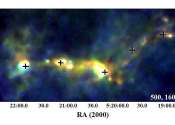
Researchers investigate three star-forming regions, identify hundreds young stellar objects
Using data from various space telescopes and astronomical surveys, Armenian researchers have investigated three star-forming regions. The study identified hundreds of young stellar objects and provided important information ...

Astronauts to patch up NASA's NICER telescope
NASA is planning to repair NICER (Neutron star Interior Composition Explorer), an X-ray telescope on the International Space Station, during a spacewalk later this year. It will be the fourth science observatory in orbit ...
Astronomy
Apr 17, 2024
0
14

NASA's Roman space telescope's 'eyes' pass first vision test
Engineers at L3Harris Technologies in Rochester, New York, have combined all 10 mirrors for NASA's Nancy Grace Roman Space Telescope. Preliminary tests show the newly aligned optics, collectively called the IOA (Imaging Optics ...
Astronomy
Apr 17, 2024
0
30

Researchers unveil unique tidal disruption event with pronounced early optical bump
A research team from the University of Science and Technology of China (USTC) of the Chinese Academy of Sciences (CAS) presented a detailed analysis of a tidal disruption event (TDE) with unique characteristics, providing ...
Astronomy
Apr 17, 2024
0
14

Researchers propose new formation model for massive hot subdwarfs
In a new study published in the The Astrophysical Journal, Dr. Li Zhenwei and his collaborators from Yunnan Observatories of the Chinese Academy of Sciences (CAS), and Dr. Zhang Yangyang from the Zhoukou Normal University, ...
Astronomy
Apr 17, 2024
0
1

NASA observations find what helps heat roots of 'moss' on sun
Did you know the sun has moss? Due to its resemblance to the earthly plants, scientists have named a small-scale, bright, patchy structure made of plasma in the solar atmosphere "moss." This moss, which was first identified ...
Astronomy
Apr 17, 2024
0
14
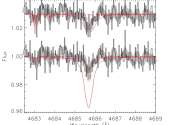
Astronomers discover the most metal-poor extreme helium star
Using the Southern African Large Telescope (SALT), astronomers have performed high-resolution observations of a recently detected extreme helium star designated EC 19529–4430. It turned out that EC 19529–4430 is the most ...
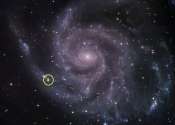
NASA's Fermi mission sees no gamma rays from nearby supernova
A nearby supernova in 2023 offered astrophysicists an excellent opportunity to test ideas about how these types of explosions boost particles, called cosmic rays, to near light-speed. But surprisingly, NASA's Fermi Gamma-ray ...
Astronomy
Apr 16, 2024
0
815

Citizen science project classifying gamma-ray bursts
When faraway stars explode, they send out flashes of energy called gamma-ray bursts that are bright enough that telescopes back on Earth can detect them. Studying these pulses, which can also come from mergers of some exotic ...
Astronomy
Apr 16, 2024
0
2

A solar neighborhood census, thanks to NASA citizen science
To take a census of nearby cosmic objects, sending out a survey won't work. Scientists need to use many telescopes with different specializations to chart what is in the general neighborhood of the sun.
Astronomy
Apr 16, 2024
1
95

Why figuring out how potassium is destroyed in stars is important to understanding the universe
If you want to know where elements come from, look to the stars. Almost every element heavier than helium is formed through nuclear reactions in stars. But which stellar processes are responsible for these elements? Can we ...
Astronomy
Apr 16, 2024
0
31
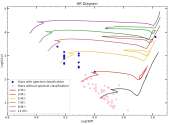
Astronomers inspect open cluster Berkeley 50
Using the Lowell Discovery Telescope (LDT), astronomers from the Lowell Observatory in Flagstaff, Arizona, have observed a young Galactic open cluster known as Berkeley 50. Results of the observational campaign, presented ...
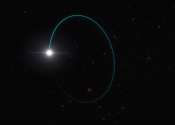
Most massive stellar black hole in our galaxy found
Astronomers have identified the most massive stellar black hole yet discovered in the Milky Way galaxy. This black hole was spotted in data from the European Space Agency's Gaia mission because it imposes an odd 'wobbling' ...
Astronomy
Apr 16, 2024
1
681

Rubin observatory will reveal dark matter's ghostly disruptions of stellar streams
Glittering threads of stars around the Milky Way may hold answers to one of our biggest questions about the universe: what is dark matter? With images taken through six different color filters mounted to the largest camera ...
Astronomy
Apr 15, 2024
1
38

The brightest gamma ray burst ever seen came from a collapsing star
After a journey lasting about two billion years, photons from an extremely energetic gamma-ray burst (GRB) struck the sensors on the Neil Gehrels Swift Observatory and the Fermi Gamma-Ray Space Telescope on October 9th, 2022. ...
Astronomy
Apr 15, 2024
0
75

Formation-flying spacecraft could probe the solar system for new physics
It's an exciting time for the fields of astronomy, astrophysics, and cosmology. Thanks to cutting-edge observatories, instruments, and new techniques, scientists are getting closer to experimentally verifying theories that ...
Astronomy
Apr 15, 2024
0
37

Neutron stars could be heating up from dark matter annihilation
One of the big mysteries about dark matter particles is whether they interact with each other. We still don't know the exact nature of what dark matter is. Some models argue that dark matter only interacts gravitationally, ...
Astronomy
Apr 15, 2024
0
10

Hydrogen recombination found to be most plausible explanation for high levels of energy in stellar superflares
Although their primary purpose is to look for exoplanets, observatories like the Kepler Space Telescope and the Transiting Exoplanet Survey Satellite (TESS) have supplied a vast amount of data on stellar flares, detected ...
Astronomy
Apr 15, 2024
0
770
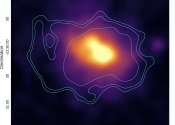
Astronomers detect radio halo in a massive galaxy cluster
An international team of astronomers has performed radio observations of a massive galaxy cluster known as ACT-CL J0329.2-2330, which resulted in the detection of a new radio halo in this cluster. The finding was reported ...
Other news

Baby white sharks prefer being closer to shore, scientists find

Key protein regulates immune response to viruses in mammal cells

Research team resolves decades-long problem in microscopy

RNA's hidden potential: New study unveils its role in early life and future bioengineering

NASA's Juno gives aerial views of mountain and lava lake on Io

Smoother surfaces make for better accelerators

Materials follow the 'Rule of Four,' but scientists don't know why yet

Invasive species sound off about impending ecosystem changes


















































